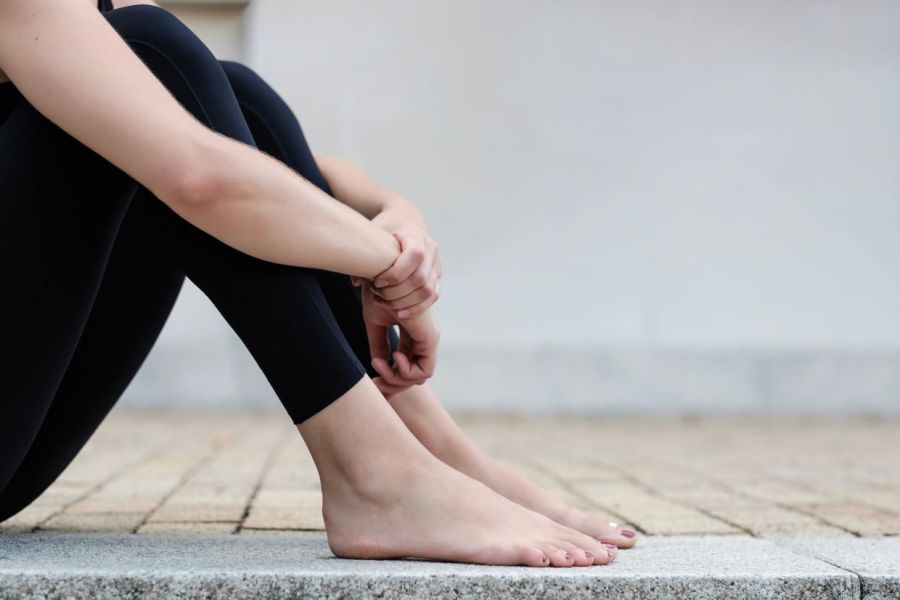Strengthening your upper legs with yoga won’t just improve your daily functional movement, it will boost your sporting performance, too. We’re taking a closer look at the anatomy of your leg muscles, before revealing the best yoga poses for building strength in your lower body…
Related: What is yoga? Benefits & basic principles for beginners
Struggling to meet your fitness goals? Building lower body strength has many sporting benefits, especially for activities that involve running, jumping or kicking. Whether it’s powering your sprints for a better PB or building your strength to run further for longer, training your legs will do wonders for your running.
Time spent in the saddle will reap the benefits, too, both during indoor cycling sessions and out on the open road. Add to this, increased muscle tone and a shapelier silhouette, it’s clear that factoring in time on your mat to build leg strength will pay dividends. First up, a little anatomy.
Related: Best yoga poses to stretch and strengthen your back
The anatomy of your leg muscles
Along with the largest muscle group in the body, the quads (see below), the other main muscles of the thighs are the hamstrings (semimembranosus, semitendinosus and biceps femoris), which flex the knee joint, extend the hip and turn the lower leg in or out when the knee is fixed.
Other important muscles of the thighs include tensor fasciae latae, which flexes, rotates and abducts the hip joint, the adductors (magnus, brevis and longus) which draw your legs together, and sartorius, a superficial muscle that enables you to sit cross legged.
Quadriceps anatomy
Get to know the power muscles in your legs…
Officially known as quadriceps femoris (quadriceps means four-headed), your quads refer to four individual muscles – vastus medialis, which lies on the inside of your thigh; vastus lateralis, on the outside; vastus intermedius in between the two, and rectus femoris, which lies over intermedius.
In recent years, a fifth muscle, tensor vastus intermedius, has been discovered to form part of this group as well. With all of them converging in the patella (knee) tendon, their combined role is to straighten your knee when walking, climbing and rising from a seated position. They also help stabilise the knee by holding the patella inside a groove in the femur.
- Action: The vasti muscles extend the knee joint. Rectus femoris – extends the knee and flexes the hip.
- Everyday use: Walking up stairs, cycling
- Sports use: Cycling, skiing, running, weight-lifting, football
- Common problems: Lower back pain, knee pain and knee instability, especially if quads are weak or tight
- Stretching poses: Bridge, reclining hero, dancer (raised leg)
- Strengthening poses: Warrior poses, chair, Goddess pose
Related: Yoga for core strength: best poses for stronger abs
Best yoga poses for leg strength
Try the following yoga sequence to strengthen your legs…
- Chair
- Eagle
- Warrior II
- Standing head-to-knee pose
- Half moon
How to use these yoga poses:
Warm up with cat/cow, tiger pose and a seated twist or lying twist, then generate heat in your body with a couple of half sun salutes (mountain pose, extended mountain pose, forward fold, half forward fold). Follow this with two or three rounds of sun salute A (mountain pose, extended mountain pose, forward fold, half forward fold, low plank, upward dog, downward dog, half forward fold, forward fold, extended mountain pose, mountain pose).
Related: Full body yoga warm up: 7 best exercises & poses
For the main sequence, perform each pose in order, remaining in the pose for up to a minute (longer if you have an established practice) and repeat on both sides of the body if needed. Repeat the circuit once more. Finish with a few minutes in legs up the wall, then rest in savasana for five to 10 minutes.
Keep reading for full instructions on how to perfect each leg-strengthening yoga pose.
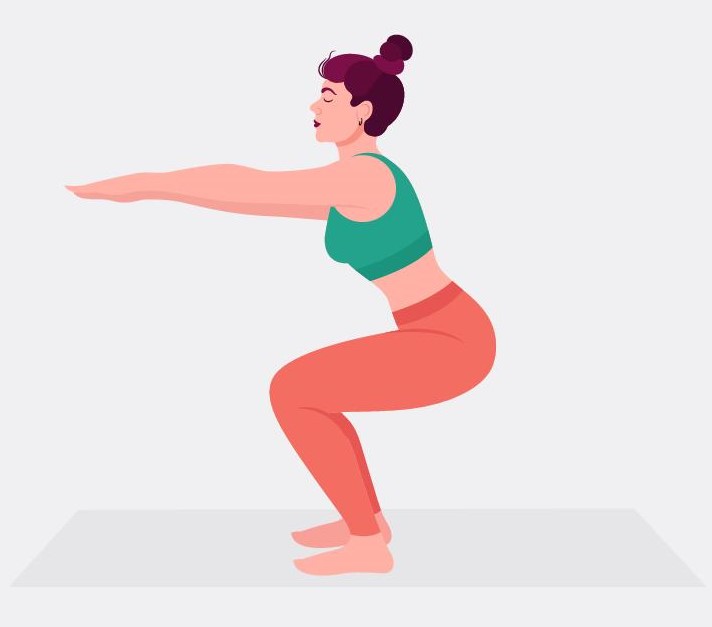
1. Chair
Good for: Strengthens the quads and calves, stretches the shoulders and chest
Leg focus: Rectus femoris flexes the hip and tilts pelvis forwards. Vastus muscles engage and lengthen to bend and stabilise the knee. Hamstrings engage, calf muscles engage while stretching.
Alignment: Stand with feet hip-width apart and fold forward, letting your arms hang by your sides.
How to do the chair pose:
- Bend your knees deeply, take your arms backwards and look forward.
- On an inhale, ground through the base of your big and little toes, and sweep your arms up and forward, palms facing, until your upper arms are level with your ears.
- Draw your belly button to your spine and allow your shoulder blades to release down your back. Lengthen your spine and extend through to your fingertips, at the same time as drawing your arms into your shoulder sockets.
- Keep neck in line with the spine.
Make it easier: Keep arms parallel to the floor (pictured).
Make it harder: Rise onto your toes, or take hands to prayer, twist to right and hook left elbow outside right thigh. Repeat on the other side.
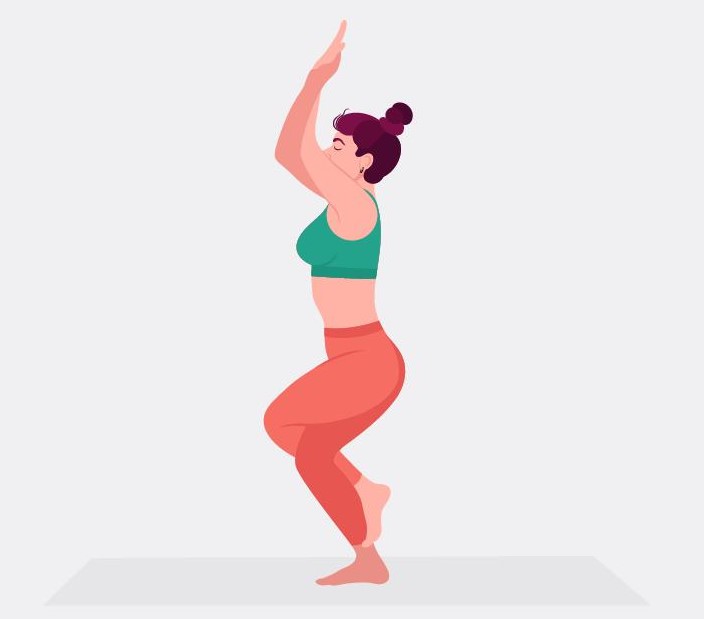
2. Eagle
Good for: Standing on one leg increases the benefits of chair pose. Improves balance and grounding
Leg focus: Standing leg – quads and calf muscles as chair. Wrapped leg – the peroneus muscle on the lower leg tilts the ankle so it can hook around the opposite calf.
Alignment: Take your weight onto your right foot, bend your right knee and place left thigh over right, then wrap your left calf around your right calf, hooking your toes round it.
How to do the eagle pose:
- Softly inhale as you float your arms out to the sides to shoulder height.
- On an exhale, cross your arms in front of you, left elbow on top of right, then intertwine your forearms to bring your palms together, thumbs facing you and fingertips pointing up.
- With your forearms vertical, draw your shoulder blades down your spine, and raise your elbows to open up the space between your shoulder blades.
- Gently release and switch sides.
Make it easier: Practise with arms only, then legs only.
Make it harder: Remain in the pose longer, or try with closed eyes.
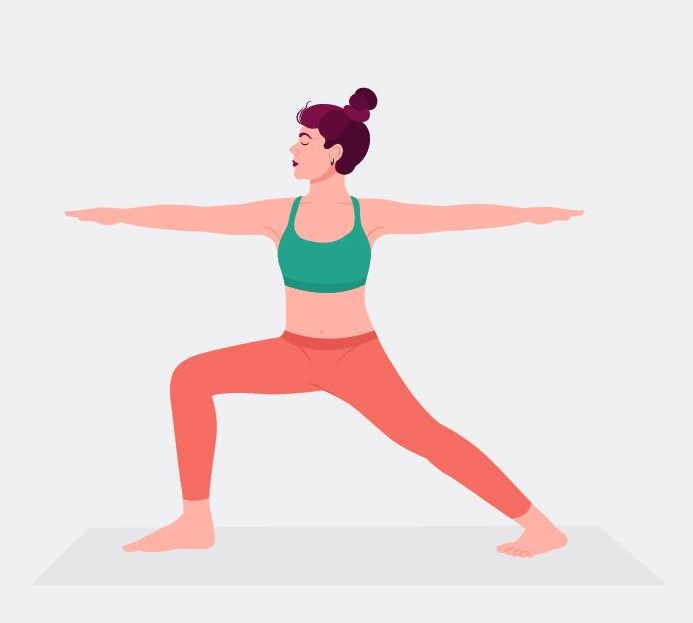
3. Warrior II
Good for: Strengthens the hip flexors and quads, along with the core. Builds endurance
Leg focus: Quads engage while lengthening in both legs and stabilising the front knee. Rectus femoris in front leg engages to flex the hip.
Alignment: Facing sideways on your mat, turn your right foot out 90 degrees, left foot in 15 degrees. Root through big and little toes, raise your inner arches and ground through outside edge of left foot. Keep weight balanced evenly between both feet, and keep your pelvis in neutral.
How to do the Warrior II pose:
- On an exhalation, bend your right leg to take your knee directly over your ankle, keeping a micro-bend in your left leg.
- Inhale to raise your arms to the sides, palms facing the floor. Lengthen from your centre to beyond your fingertips. If comfortable, turn to look over your right arm.
- Gently release and switch sides.
Make it easier: Place hands on hips, or press back foot against a wall.
Make it harder: Lower until front thigh is parallel to the ground (pictured).
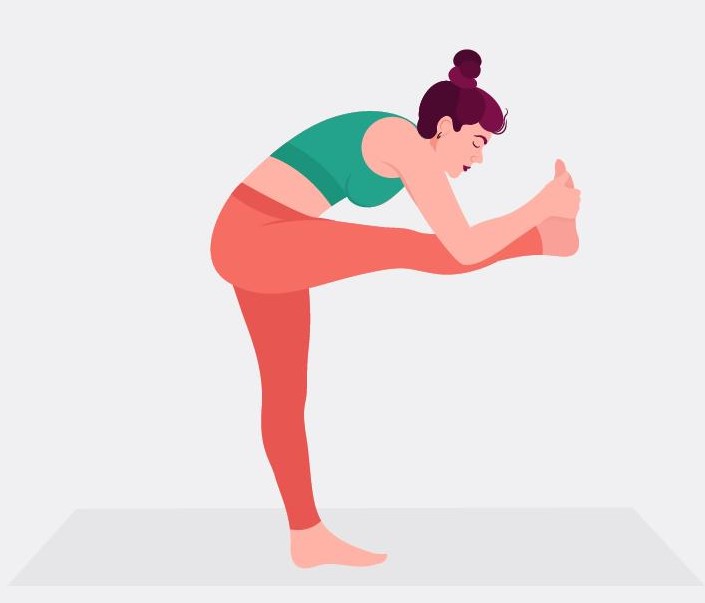
4. Standing head-to-knee pose
Good for: Strengthens the legs, lengthens hamstrings, builds core, improves balance and focus
Leg focus: Standing leg – rectus femoris stabilises the leg, the combined quads straighten the leg.
Alignment: From standing, transfer your weight to your left leg.
How to do the standing head-to-knee pose:
- Grounding through that foot, bring your right knee to your chest and interlace your fingers around your foot, elbows either side of your calf.
- Check your balance, then straighten your raised leg.
- Tuck in your chin, lengthen your spine on an inhalation and fold forward towards your raised leg on an exhalation.
- Activate your core and thighs to help stabilise the pose and ground through your foot to maintain balance.
- Gently release and switch sides.
Make it easier: Wrap a strap around your raised foot and grasp each end.
Make it harder: Increase length of time in the pose or close your eyes.
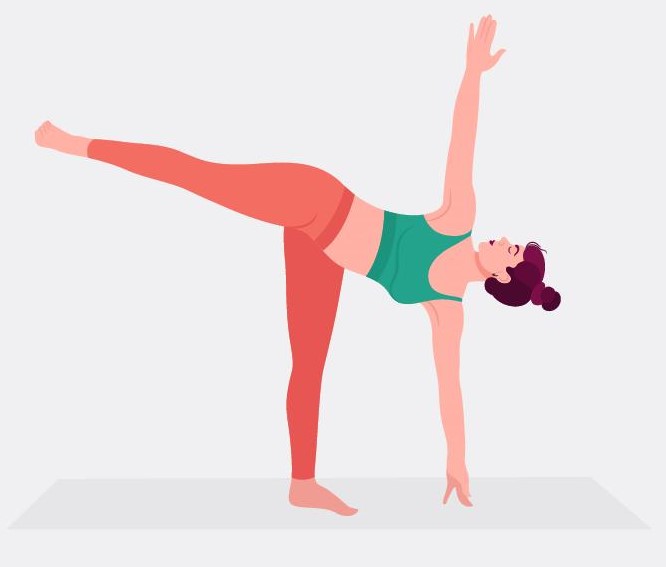
5. Half moon
Good for: Tones the lateral muscles of the legs, strengthens knees and legs, increases hip flexibility, boosts energy
Leg focus: Standing leg – rectus femoris stabilises the leg, the combined quads straighten the leg. Raised leg – quads straighten the knee.
Alignment: Stand with feet 3ft apart, turn left foot out 90 degrees and left foot in slightly. Bend your left knee and place your hand
18 inches in front of your foot.
How to do half moon pose:
- Transfer weight onto your left hand and foot, raising right leg as you do so.
- Ground through your left foot, and rotate your chest and pelvis open, so hips and shoulders are stacked one above the other.
- Raise your top arm to the ceiling. Breathe evenly from the belly, imagining there are lines of energy travelling out from your centre.
- Gently release and switch sides.
Make it easier: Place upper hand on hip, place a block beneath lower hand, rest back foot against a wall.
Make it harder: Float lower hand just above the floor or close eyes.
Create your own leg-strengthening yoga sequences:
PlayPauseBe Yoga Expansion Deck (£32)
Creating your own yoga sequences has never been easier with these beautiful cards. Now a new expansion deck has duplicate poses (so you can repeat postures several times in a sequence), bonus cards to remind you to pause at key moments in your practice and 12 intentional cards (such as confidence, grounding, self-love) to inspire different themes for your sessions. We love them.
Read next: Lina Nielsen: ‘Yoga has made me a better athlete’
Words: Eve Boggenpoel | Images: Shutterstock

